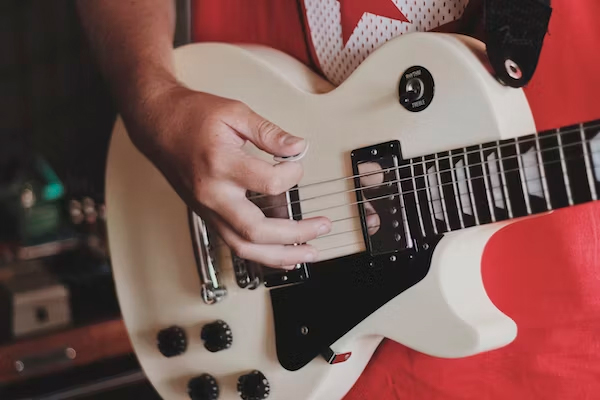
How to Install a Whammy Bar: Adding Flair to Your Guitar Play. Considering a whammy bar for a unique sound? Dive into this guide for essential insights before embarking on the relatively easy installation process. Learn about the different types of whammy bars, their impact on pitch modulation, and crucial tips to enhance your playing. Whether you’re a seasoned guitarist or a beginner, this comprehensive overview ensures you’re well-prepared to maximize the potential of your instrument.
Table of Contents
Can You Install a Whammy Bar on Any Guitar?
The short answer is no. While it is possible to install a whammy bar on any electric guitar (like a Fender Stratocaster guitar or Fender Telecaster, surf guitar, Gibson SG or Les Paul electric guitars), not all acoustic guitars of guitar players are designed to accommodate one. If your acoustic guitar has a flat top, it is not recommended to install a whammy bar on a guitar as it can damage the guitar’s structural integrity.
However, if your electric guitar has a tremolo system or a bridge that can accommodate a whammy bar on your guitar, then you’re in luck! Most guitarists like to explore new sounds, so installing a whammy bar is a great improvement. And if your favorite online guitar shop is a participant in the Amazon services LLC associates’ program, you should buy a whammy bar from them.
Does the Whammy Bar Just Screw In?
Yes, the whammy bar is attached to the guitar bridge using a screw to increase tension. However, the details of attaching a whammy bar to a guitar can vary depending on the type of guitar strings, vibrato system and whammy bar you have. Some whammy bars come with a locking mechanism that requires you to push the whammy bar into the hole and twist it to secure it in place.
How Tight to Screw in Whammy Bar?

Image by Hector Bermudez from Unplash
It’s important to not overtighten the whammy bar screw as it can strip the threads in the guitar body. It’s recommended to screw it in until it’s snug but not too tight. Find the whammy bar that is right for your guitar. Before you install the whammy bar, best to ask for advice from a professional about the body of the guitar and how it will affect playing the guitar.
Do Whammy Bars Damage Guitars?
When used correctly, whammy bars do not damage guitars. However, if you use the whammy bar excessively or improperly, it can cause your guitar to go out of tune or even break strings. It’s important to use the whammy bar in moderation and not force it beyond its natural range of motion. It would be good to install a whammy made specifically for your guitar; it will turn a guitar into an amp.
Whammy bar brings new sound when you install one and plug your guitar to start playing guitar. But you do not need to install a whammy bar into the bridge of an electric guitar if the whammy bar is used very rarely by you. A whammy bar is pulled or pushed into the guitar when needed.
Does Jimi Hendrix Use Whammy Bar?
Yes, Jimi Hendrix was known for his use of the whammy bar to create his signature vibrato sound. He used it to great effect on songs like “Purple Haze” and “Voodoo Child (Slight Return).” The whammy bar or tremolo bar helped him create a unique sound. But the sound also depends on the types of whammy bars.
What Guitars Can Use a Whammy Bar?
Most electric guitars can accommodate a whammy bar, but it’s important to check the type of bridge your guitar has to ensure compatibility. Guitars with a Floyd Rose or synchronized tremolo bridge are designed to work with whammy bars. You might want to install a whammy bar on all guitars, so that music created by your guitar is more interesting, but it is not always possible to add the whammy bar.
Who is the King of Whammy Bar?
Eddie Van Halen is often considered the king of the whammy bar. He used it to great effect on songs like “Eruption” and “Panama,” and his innovative techniques helped popularize the use of the whammy bar in rock music. If you want to repeat his sound and the sound of guitarists like Eddie Van Halen, push the bar into your guitar, it is quite easy to install. Whammy bar helps with bending the guitar strings, adjust the whammy bar towards the string if it is not installed properly.
How to Install a Whammy Bar?
To attach a whammy bar, first locate the whammy bar hole on the bridge of your guitar. Insert the whammy bar into the hole and screw it in until it’s snug but not too tight. Some whammy bars on modern guitar models come with a locking mechanism that requires you to twist the bar to secure it in place.
Please note that there are different types of tremolo systems, guitars do not come with one universal way of installing a tremolo bar for bending the strings. Don’t use an inappropriate tremolo bar for a guitar, you might damage it. But you can use a bit of power to reduce or increase tension.
Are Whammy Bars Universal?
No, whammy bars come in different sizes and shapes, and not all are compatible with every type of guitar. It’s important to find the right whammy bar for your guitar to ensure proper installation and performance.
Should Whammy Bar be Tight or Loose?

Image by Robbie Down from Unplash
The whammy bar should be snug but not too tight which might depend on the type of whammy bar. Overtightening the screw can damage the threads in the guitar body, while a loose whammy bar can affect the sound of your guitar.
Tips
– Before installing a whammy bar, make sure your guitar is properly tuned.
– Use your whammy bar in moderation to avoid damaging your guitar or breaking strings.
– Experiment with different techniques to find the sound you’re looking for.
Warnings
– Improper use of the whammy bar can damage your guitar or cause it to go out of tune.
– Be careful not to overtighten the whammy bar screw as it can damage the guitar body.
Installing a whammy bar can be a great way to add depth and character to your guitar playing because you bend the strings. By following the tips and guidelines above, you can attach a whammy bar to your guitar and use it to create a unique sound. Remember, practice makes perfect, so don’t be afraid to experiment and find the techniques that work best for you.






